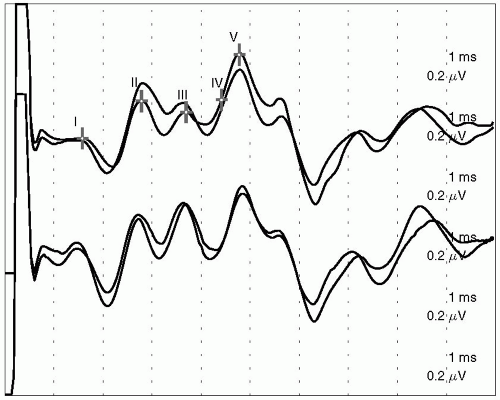Brainstem Auditory Evoked Potentials
QUESTIONS
1. Wave I is generated by:
A. Distal 8th nerve
B. Inferior colliculus
C. Lower pons
D. Mid brain
View Answer
1. (A): Wave I of BAEP is a negative wave recorded at the ear, with an average latency of 1.4 ms in healthy subjects. Wave I is generated by distal 8th nerve action potentials. (Chiappa 1997, p. 200)
2. Select the correct statement:
A. Infants are best tested with a single phase click with rarefaction
B. Infant responses are larger in amplitude
C. Hearing threshold in infants is usually 50 dB NHL
D. Evoked potential (EP) abnormalities are permanent and serial testing is not needed
View Answer
2. (A): The BAEP is recorded in normal infants at 30 dB NHL with rarefaction clicks. Infant BAEP responses are lower in amplitude. The BAEP abnormalities are usually transient and may need serial testing. (Chiappa 1997, pp. 270, 277)
3. Wave V shown in Figure 9.1 is generated by:
A. Distal 8th nerve
B. Superior colliculus
C. Lower pons
D. Midbrain
View Answer
3. (D): Wave V of the brainstem auditory evoked potential is thought to be generated at the level of the inferior colliculus and an absence of wave V would suggest a lesion of the lower midbrain at the level of the inferior colliculus. (Chiappa 1997, p. 202)
4. Click threshold is the intensity at which the subject can:
A. Barely hear the clicks
B. Hear the clicks the best
C. Above which clicks disappear completely
D. None of the above
View Answer
4. (A): Hearing threshold is the intensity at which the subject can barely hear the click. The stimulus intensity used is 65 or 70 dB above the hearing threshold. (Chiappa 1997, p. 160)
5. Masking noise is:
A. Clicking noise used for testing the ear
B. Low-intensity noise used for masking the contralateral ear
C. Clicking noise producing the best waveforms
D. Not used in humans
View Answer
5. (B): If there is asymmetric gross abnormalities of hearing function then cross-stimulation may be confusing factor. A masking noise at an intensity of 30 to 40 dB less than the stimulus intensity is used in the contralateral ear. (Chiappa 1997, p. 171)
6. No significant difference in latencies or amplitudes when brainstem auditory evoked potentials (BAEPs) are recorded simultaneously with needle and surface electrodes.
A. True
B. False
View Answer
6. (A): Needle electrodes are as good as scalp electrodes. In order to make wave I more well defined a needle electrode is used in the anterior wall of external auditory canal. A conventional small thin wire, sterile electroencephalogram (EEG) needle electrode is used. The electrode impedance is usually approximately 5,000 ohms. (Chiappa 1997, p. 162)
7. To make wave Imore prominent and to get rid of cochlear microphonics:
A. Use contralateral ear recording
B. Use rarefaction clicks
C. Use condensation clicks
D. Alternate between rarefaction and condensation
View Answer
7. (D): Rarefaction tends to have a higher amplitude of wave I. Cochlear microphonics unlike wave I change polarity with changing click polarity. Alternating between rarefaction and condensation helps in getting rid of cochlear microphonics. (Chiappa 1997, p. 171)
8. For BAEP, low frequency filter should be:
A. 1 Hz
B. 10 Hz
C. 100 Hz
D. 1,000 Hz
View Answer
8. (C): The filters are set at 50 to 150 Hz low-frequency filter and 3,000 Hz high-frequency filter with sweep duration of 10 ms. (Chiappa 1997, p. 164)
9. For BAEP, high frequency filter should be:
A. 3 Hz
B. 30 Hz
C. 300 Hz
D. 3,000 Hz
View Answer




9. (D): The filters are set at 50 to 150Hz low-frequency filter and 3,000Hz high-frequency filter with a sweep duration of 10 ms. (Chiappa 1997, p. 164)
Stay updated, free articles. Join our Telegram channel

Full access? Get Clinical Tree






